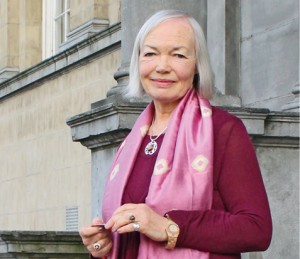
As mentioned elsewhere in this issue, this year’s One City, One Book is a break from the usual form of adopting an old favourite or reviving a neglected classic.
Instead, the book is an anthology, If Ever You Go: a Map of Dublin in Poetry and Song, in which authors old and new, deceased or still kicking (and scribbling) are brought together to showcase the city as they and their muse are given to see it.
The promotional campaign involves a long series of literary events held throughout the city, and some of these are readings which are hosted at the Pearse Street Library under the auspices of the current Senior Librarian, Phil Scanlan.
NewsFour was in attendance at the library when Ringsend resident Mary Guckian, pictured right, read a selection of her own work to an attentive crowd, and we caught up with her afterwards for a chat about her art and how her locale feeds into the work.
Mary has been resident on Joy Street for 20 years and is a member of the Rathmines Writers Group, her involvement in which she credits as helping to make a real poet out of her, “not that I’m sure I can claim to be a real poet,” she adds modestly.
Mary explains that she grew up in Leitrim, on a farm outside Carrick-on-Shannon, and that the inspiration for her poems often begins with something in the city that triggers an association with the country. “I seem to be steeped in the country, still, to this day,” she says, “It is strange how something hits you. It might be something like – this happened to me – a guy feeding seagulls down by the docks. I was taking a walk at lunchtime when I saw him, and when I got home in the evening, the image just unravelled in my head and became a poem.”
Mary always had an impulse to write and feels it is somehow innate, the desire to become a poet. “Something in me always wanted to write. Even as a child, when I was tired after a day helping on the farm, and there was nothing new to read, I would keep a diary.” As a young woman, she wrote historical pieces for the Leitrim Guardian, but didn’t start to write poetry until her thirties.
Mary credits a stay in Australia, from 1973 to 1975, as helping to encourage her somehow, along with the Rathmines Writers Group. “Every two weeks, we have to have something finished, to share, which is great, as otherwise I doubt I would have finished my first poems.”
Mary redrafts work frequently. Is she one of those writers who hates to write? “Well, I love the feeling of having finished a poem, you could put it that way.”
Talking about locations a little, she says that Ringsend has grown on her greatly, to the point where she now loves it, and its diversity as a place. “It was very quiet when I first came here years ago. Now it’s such a mix of young and old, and the Google building has brought quite a lot of life to the Docklands. And I love the walk to Ballsbridge, for the canal.”
See www.dublinonecityonebook.ie/events-2014 for more events.
Cranes and Crosses
By Mary Guckian
On St. Brigid’s Eve,
Driving home from work
Eleven long armed cranes
Hang from fragile clouds
Over homes in Ringsend.
Men relax, having climbed
Down from their cages-
After spending a long day
Suspended between earth
And sky, moving fixtures
That have turned an empty
Site into a living space.
The interweaving of stark
Metal above my head takes
Me out of the city and
Away from chilling greyness
Of cement and glass, where
Apartments, hinged tightly
Together, are modern homes
For single people, sharing
Alongside smart google
Operators who puff smoke
From cigarettes outside
In the cool frosty air.
I am back in the last century,
Walking on purl stitched soil
Patterned by cattle footprints
Where we pulled green stalks
From damp earth, sucked dry
Coconut flavour from inside
Stems, savouring the vapid tang.
With a scissors we cut bundles
Of the taller rushes, carrying
Them to our homes, where we
spent hours weaving fragile
crosses for St. Brigid’s Eve.
Hammering Sounds
By Mary Guckian
Hammering sounds
from Barrow Street
hangs around my home
in the morning
as metal hits metal
and the Metro Verde
building rises
to sixteen storeys.
Taking milk
from the fridge
for breakfast
I see carts packed
with creamery cans,
horses and donkeys
swaying side to side
climb Mary Ann’s Hill.
Echoes of iron
ring across the farm
as cans are pushed
across the platform
of Kiltoghert Creamery,
emptied into vats
for buttermaking,
shifted back on shiny
dark stone and refilled
with skim milk.
When my Father
was in hospital
I waited at the lane
for a farmer
to take our milk
to the creamery.
Despite packed carts
one kind person daily
lifted a full can
on to the cart
to my childish delight.
Telescopic Gas Holders
By Mary Guckian
In March
I came to live in Joy Street,
and took a picture
of my house,
and the engineering feat
that crowned the street.
From this place
men came home at sunset,
blackened from the coal
they filled the furnace with,
to make the gas
that ballooned into the crown
each evening,
In July
the cranes move in.
I listened to the scream
and crunch
of contorting rusted metal,
as they crushed
Victorian grandeur
into dust.
Now
my house seems bleak
without the treat
enjoyed each evening,
when patterned sunsets
silently faded
behind the stately
Gasometer.
Article By Rúairí Conneely

